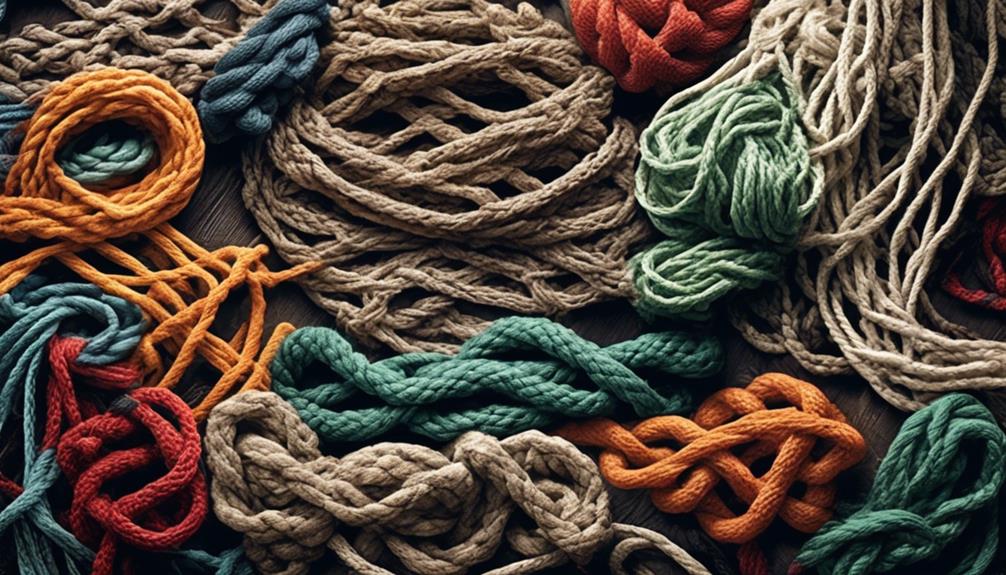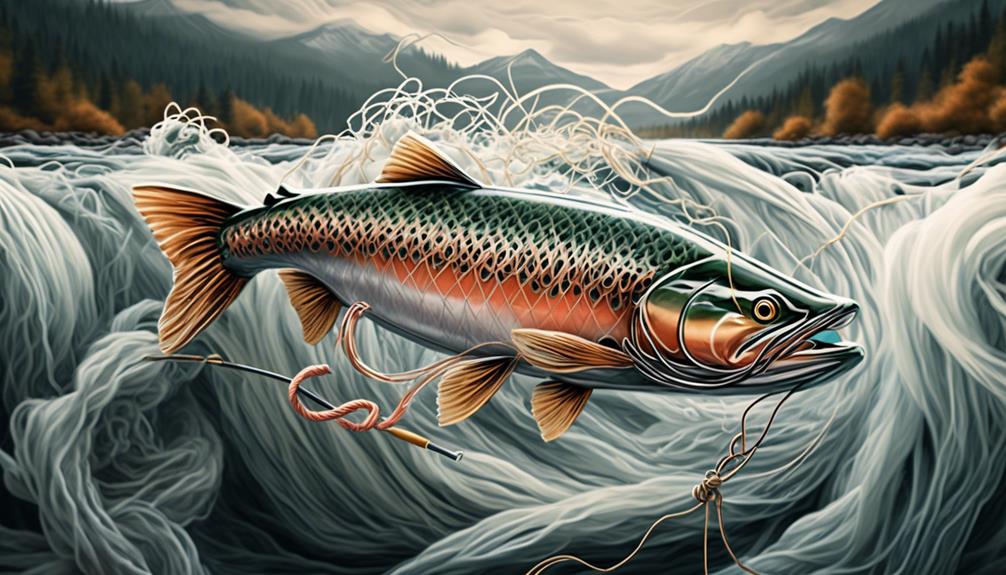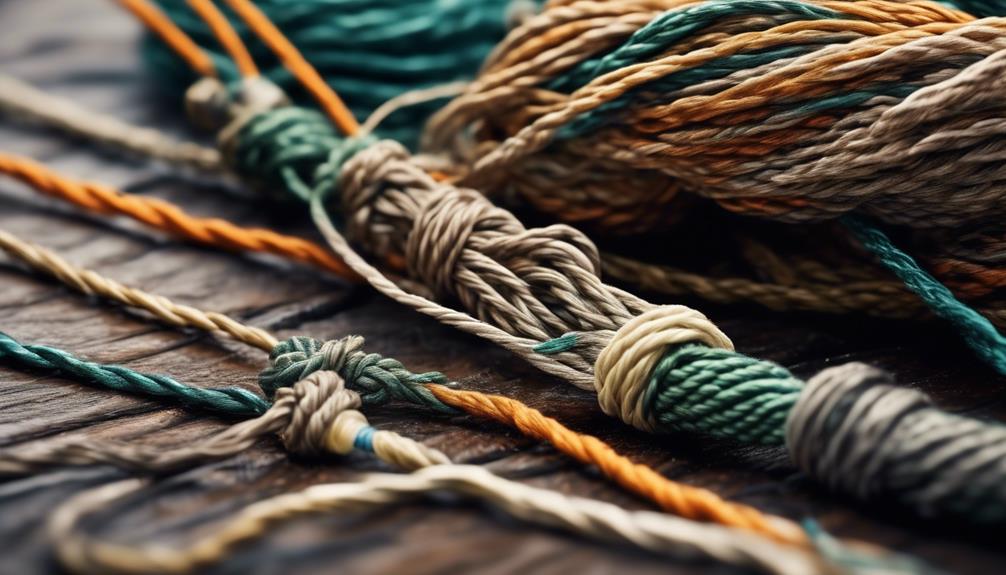When it comes to trout fly fishing, finding the best knots for securing your flies is like uncovering hidden treasures in the depths of the water. You want knots that are reliable, strong, and won't let you down when you've hooked a beautiful trout.
But with so many options out there, how do you know which knots are the best for your fly fishing adventures? Well, you're in luck because we're about to unravel the mystery and guide you through the top trout fly fishing knots that will elevate your angling experience to a whole new level.
Improved Clinch Knot
The Improved Clinch Knot is a reliable and essential knot for securing a fishing hook to the line. Its knot strength is impressive, making it a popular choice among anglers. To achieve maximum knot strength, it's essential to master the proper knot tying technique.
To tie the Improved Clinch Knot, start by threading the line through the eye of the hook and then doubling back parallel to the standing line. Next, twist the tag end around the standing line at least five to seven times. After completing the twists, thread the tag end back through the loop formed near the eye of the hook. Finally, moisten the knot and pull the tag end to tighten the knot, ensuring it cinches neatly against the eye of the hook. Trim any excess tag end for a clean finish.
Mastering the knot tying technique is crucial to ensure the knot's strength. Properly cinching and tightening the knot is essential to prevent slippage, especially when battling feisty trout. When tied correctly, the Improved Clinch Knot provides the necessary strength and security to withstand the vigorous fights that trout are known for.
Palomar Knot
Mastering the Improved Clinch Knot is crucial, but when you're ready to secure a larger hook or lure, the Palomar Knot is an excellent choice for its strength and reliability. The Palomar knot strength is renowned among anglers, making it a preferred knot for securing hooks, lures, and swivels. Its simplicity and efficiency make it a valuable skill for any angler to master.
To tie a Palomar knot, begin by doubling about 6 inches of line and passing it through the eye of the hook. Then, tie a simple overhand knot with the doubled line, creating a loop large enough to pass the hook through. After threading the hook through the loop, moisten the knot and pull both ends of the line to tighten it. Trim the tag end for a clean finish. The Palomar knot's strength lies in its double-line design, distributing the force across a greater area and minimizing the risk of breakage.
When tying the Palomar knot, it's essential to ensure that the knot is pulled tight and properly seated against the hook eye. This will prevent any slippage during casting or retrieving, providing the confidence that your knot will hold when reeling in a trophy trout. With its high strength and ease of tying, the Palomar knot is a valuable asset in any angler's repertoire.
Non-Slip Loop Knot
When tying the Non-Slip Loop Knot, consider using a small loop for your line to ensure optimal performance. This knot is an excellent choice for adding a loop at the end of your line, allowing for versatile applications such as attaching flies, hooks, or lures. One of the key advantages of the Non-Slip Loop Knot is its ability to maintain a consistent and strong loop, which is essential for effective fly fishing.
To tie this knot, start by doubling the line and forming a small loop. Then, make an overhand knot with the doubled line, passing the loop through the eye of the hook or lure. Next, wrap the tag end around the standing line, passing through the overhand knot from the bottom and then through the loop. Moisten the knot before carefully drawing the tag end and the standing line to tighten the knot securely. To ensure its strength, trim the tag end, leaving a small tag to prevent slippage.
The Non-Slip Loop Knot is particularly useful when fishing with streamers, nymphs, or dry flies. Its strong and secure loop allows for natural movement of the fly in the water, enhancing its presentation and increasing the chances of enticing a strike from trout. When tying this knot, remember to maintain a consistent and small loop size for optimal performance.
With its reliable strength and versatility, the Non-Slip Loop Knot is a valuable addition to any trout angler's repertoire.
Double Surgeon's Knot
For tying the Double Surgeon's Knot, consider using an easy and reliable method to connect two lines together securely. This knot is popular for its simplicity and strength. When compared to other knots, the Double Surgeon's Knot holds its own in terms of strength, making it a trustworthy choice for securing lines together. Its simplicity and reliability make it a favorite among anglers, especially when connecting lines of similar diameters.
The Double Surgeon's Knot is formed by creating two overhand knots and then passing both tag ends through the loops twice before moistening and tightening the knot. This process ensures a secure connection that can withstand the force of a fighting trout.
The Double Surgeon's Knot is best suited for joining two lines of similar diameters, making it ideal for trout fly fishing. It's commonly used to attach tippet to the leader or to join two sections of tippet material. This knot is particularly useful when you need to quickly extend or repair your leader while out on the water. Its strength and ease of tying make it a valuable knot for various trout fly fishing situations, providing anglers with a reliable connection that can withstand the energetic movements of a hooked trout.
Blood Knot
Consider using a double preposition for a smoother transition, but avoid starting the sentence with 'Mastering', 'When', or 'For'. Keep the sentence concise and clear, and use an active voice and contractions.
When it comes to securing a strong connection between two lines of similar diameters, anglers often rely on the Blood Knot for its reliability and simplicity.
The Blood Knot is renowned for its exceptional strength, making it an ideal choice for joining two lines together. This knot is particularly useful in scenarios where a seamless connection is crucial, such as when attaching a leader to the main line. Its design evenly distributes pressure across the knot, preventing weak points that could lead to breakage, and ensuring that the overall strength of the line remains uncompromised.
When tying a Blood Knot, it's essential to moisten the knot before tightening it to reduce friction and heat, which can weaken the line. Additionally, ensuring that the wraps are neatly and evenly spaced will contribute to the knot's strength and reliability. Anglers also have the option to explore variations of the Blood Knot, such as the Double Blood Knot, which involves additional wraps for enhanced security.
In fishing applications, mastering the Blood Knot and its variations can significantly improve your angling experience by providing a dependable connection between lines, ultimately increasing your chances of landing that prized catch.
Davy Knot
To ensure a secure and reliable connection for your fly fishing line, consider employing the Davy Knot, a simple yet effective knot known for its strength and ease of tying. The Davy Knot is particularly advantageous for fly fishing as it retains a high percentage of the line's original strength, making it ideal for securing tippets to flies. This knot is also advantageous because it can be tied quickly and easily, even in low light conditions or when dealing with fine tippets. However, it's important to note that the Davy Knot may not be suitable for use with heavier lines or thicker diameter tippets, as it's designed for smaller, more delicate applications.
Davy Knot Advantages and Disadvantages
- Advantages
- Retains a high percentage of the line's strength
- Quick and easy to tie
- Ideal for securing tippets to flies
- Disadvantages
- Not suitable for heavier lines or thicker tippets
Davy Knot Tying Tutorial
- Double over the tag end of the tippet to form a loop.
- Pass the tag end through the loop.
- Make 4-5 turns around the standing line.
- Pass the tag end through the loop again.
- Moisten the knot and pull the tag end to tighten it against the standing line.
Orvis Knot

The Davy Knot is a valuable option for securing your fly fishing line.
Now let's focus on the Orvis Knot, another reliable knot for fly fishing. The Orvis Knot is known for its simplicity and strength, making it a popular choice among anglers. One of the advantages of the Orvis Knot is its ease of tying. It's a simple knot to master, even for beginners, and it retains a high percentage of the line's original strength when tied correctly. This reliability is crucial when you're angling for trout and need to trust that your knot won't fail you during a big catch.
However, a potential disadvantage of the Orvis Knot is that it can be a bit larger than other knots, which may affect how your fly presents in the water. Despite this, many anglers still prefer the Orvis Knot due to its proven strength.
To tie the Orvis Knot, start by threading the tag end through the eye of the hook and then double back parallel to the standing line. Create a loop by wrapping the tag end around the doubled line. Then, bring the tag end back through the loop and make 5 turns around the double line. Finally, moisten the knot and pull the tag end to tighten the coils.
There are also variations of the Orvis Knot, such as the Orvis Tippet Knot, which is specifically designed for attaching tippet to the leader. Learning different variations can be beneficial in different fishing situations.
Albright Knot
The Albright Knot is known for its strength and reliability, making it a popular choice among anglers. It securely connects two lines of different diameters, making it a versatile and valuable knot in fly fishing. This knot is particularly useful for joining a leader to a fly line or for creating a connection between different types of fishing lines.
Here are some key points about the Albright Knot:
- Albright Knot Variations: There are variations of the Albright Knot, such as the Improved Albright Knot, which involves wrapping the leader around the fly line multiple times before tying the final knot. These variations can provide additional strength and security, especially when dealing with slippery or smooth lines.
- Strength Comparison: When compared to other connection knots, the Albright Knot is often favored for its strength. It maintains a high percentage of the line's original strength when tied correctly, making it a dependable option for connecting different diameter lines.
- Albright Knot vs. Other Connection Knots: In comparison to other connection knots like the Blood Knot or Nail Knot, the Albright Knot is preferred for its ability to seamlessly join lines of varying diameters. It's also easier to tie than some other intricate connection knots, providing a practical advantage, especially when out on the water.
The Albright Knot's versatility and strength make it a go-to choice for many fly fishers, particularly when dealing with leader-to-line connections. Knowing how to tie the Albright Knot and its variations can significantly enhance your fly fishing experience.
Frequently Asked Questions
What Are the Best Trout Fly Fishing Areas or Locations to Use These Knots?
When fly fishing, finding the best trout fly fishing areas is crucial.
Ideal locations for trout fly fishing include rivers, streams, and lakes with clear water and ample aquatic insect populations.
Having the right fly fishing gear and essential equipment is key for success in these areas.
A good understanding of the water's currents and the trout's feeding habits will help you find the perfect spot to use your knots effectively.
How Do These Knots Compare to Other Types of Knots for Trout Fly Fishing?
When comparing knot strength for trout fly fishing, it's crucial to consider specialized fly fishing techniques. Different knots serve specific purposes, such as securing the fly to the tippet or joining lines together.
Some knots excel in strength, while others are easier to tie on the water. Understanding how these knots compare to other types is essential for adapting to varying fishing conditions and ensuring a successful catch.
Are There Any Specific Types of Fly Fishing Gear or Equipment That Work Best With These Knots?
When fly fishing, the right gear and equipment play a crucial role. Using the recommended knots for trout fly fishing ensures a secure connection between your line and the fly, enhancing your chances of a successful catch.
It's essential to match the knots with the type of gear you're using. While there are alternative knots, selecting the right combination of gear and knots can significantly impact your fishing experience.
Can These Knots Be Used for Other Types of Fishing, or Are They Specifically Designed for Trout Fly Fishing?
When choosing fishing knots, versatility is key. It's important to consider their adaptability for various types of fishing.
Some knots are specifically designed for trout fly fishing, but many can be used across different fishing styles.
When selecting a fishing knot, keep in mind its ability to work with different types of lines and tackle. This flexibility ensures that you have the right knot for any fishing situation.
Are There Any Specific Techniques or Tips for Using These Knots in Different Weather or Water Conditions?
When using knots in different weather, it's important to consider the impact of wind and precipitation.
Be sure to adjust your knot-tying technique to accommodate for windy conditions, using heavier lines if necessary.
In varying water conditions, such as fast-moving rivers or still lakes, choose knots that provide reliable strength and security.
Always test your knots before casting to ensure they can withstand the specific water conditions you're facing.
Conclusion
So there you have it, the best trout fly fishing knots to use on your next fishing trip.
Practice tying these knots until they become second nature, and you'll be well-prepared for any fishing situation.
Remember, the right knot can make all the difference in successfully landing that big trout.
Happy fishing!



